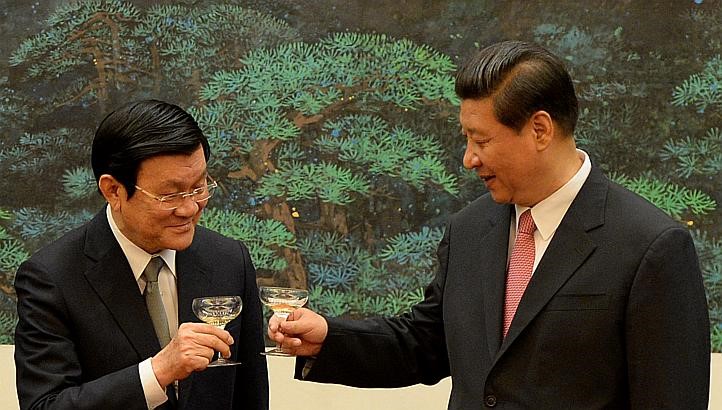 From 19 to 21 June 2013, Vietnam’s President Truong Tan Sang paid his first-ever three-day state visit to China, amid rising tensions between the two countries over the South China Sea. A communiqué issued by the Vietnamese government said that “the aim was to affirm Vietnam’s consistent policy in relations with the Communist Party of China and the State of China”. Despite China’s assertive stance on the ongoing dispute regarding maritime sovereignty, Vietnam looks to develop relations with China in “a practical manner” and expects their Chinese counterpart to reciprocate the same. In December 2012 and in January 2013, Vietnam repeatedly demanded that China “stop (and cancel) wrong activities” in the East Sea, which according to Vietnam is a “vital matter”.
From 19 to 21 June 2013, Vietnam’s President Truong Tan Sang paid his first-ever three-day state visit to China, amid rising tensions between the two countries over the South China Sea. A communiqué issued by the Vietnamese government said that “the aim was to affirm Vietnam’s consistent policy in relations with the Communist Party of China and the State of China”. Despite China’s assertive stance on the ongoing dispute regarding maritime sovereignty, Vietnam looks to develop relations with China in “a practical manner” and expects their Chinese counterpart to reciprocate the same. In December 2012 and in January 2013, Vietnam repeatedly demanded that China “stop (and cancel) wrong activities” in the East Sea, which according to Vietnam is a “vital matter”.
Tensions over maritime issues rose continuously for some time but seemed to cool off after bilateral talks in April. Both countries agreed that strategic trust in bilateral ties were needed and talked extensively about the sea area off Tonkin Gulf and decided to set up a naval hotline in June. China showed a conciliatory gesture and said that both “should make a decision to direct and push forward on seeking a political solution to the South China Sea issue”. This included joint development and demarcation in sea waters out of the mouth of Beibu Bay.
China is Vietnam’s biggest trading partner and boosting economic ties was also a major agenda in Sang’s wish-list. Managing their disputed territorial sea claims, which in May led to a damaged fishing boat and allegations of a crew’s lives being put at risk, was also on the agenda. Vietnam accused China of damaging a fishing boat that it said was operating in Vietnamese waters, risking the lives of 15 crew members. China said the Vietnamese fishing boat was fishing illegally around islands in Chinese waters. Anti-China protesters staged a show of dissent in Vietnam's capital, demonstrating the domestic pressure its government faces when dealing with China's territorial claims.
The agreement to set up an emergency naval hotline will help resolve fishing incidents in their disputed waters. The agricultural authorities that are responsible for the fishing industry in both Beijing and Hanoi signed the deal as part of efforts to prevent future disputes from derailing ties. According to the agreement, both sides should inform the other of any detentions or incidents involving fishermen or fishing boats within 48 hours. Chinese and Vietnamese fishing boats and maritime vessels periodically clash in the resource-rich and strategic South China Sea, where the countries have overlapping territorial claims. The agreement was detailed in an eight-clause joint statement released on the final day of Sang's visit to China.
Interestingly, at a time when the Vietnamese President was feted by China’s leaders, Beijing continues to shun another rival for South China Sea territory that has challenged its claims on legal grounds, the Philippines.
While China claims virtually the entire South China Sea and its island groups, Vietnam and other Southeast Asian countries claim other areas. The islands sit amid some of the world’s busiest commercial sea lanes, along with rich fishing grounds and potential oil and gas deposits. Though the claims are longstanding, new skirmishes have erupted in the last two years between China and Vietnam and the Philippines.
China claims nearly the entire 3.5 million-square-kilometer South China Sea and its island groupings. Vietnam, the Philippines, Taiwan, Malaysia and Brunei also claim parts of the sea. They often accuse Beijing of increasing aggressiveness in defending its claims. In May 2013 Vietnam accused China of risking the lives of Vietnamese sailors after a Chinese navy vessel rammed a fishing boat in an area within what Vietnam considers its exclusive economic zone. China said that the boat was fishing illegally and therefore was subject to "normal law enforcement.” Vietnam protested the highhanded action by Chinese maritime vessels in attempting to drive away the Vietnamese fishing vessels to assert Chinese sovereignty over the Paracel or Xisha islands claimed by both the countries.
On the economic front, both agreed to advance cooperation in agriculture, fishery, transportation, energy, mining, manufacturing and other fields, as well as expand trade and promote financial cooperation. Both agreed to promote balanced growth of trade and strive to attain the goal of a $60 million trade volume before 2015.
Interestingly, an editorial in China’s state-run Global Times said Xi and his Vietnamese counterpart reached a consensus in terms of some related issues, proving the possibility of a peaceful settlement of disputes in the South China Sea. Indeed the largest obstacle to a peaceful settlement between the two countries is their contradictory perceptions over the sovereignty of the South China Sea. The editorial urged that as two of the biggest neighbouring socialist countries, China and Vietnam have to meet the same goals of developing the economy through reform and opening up. It further said, since both the countries have a lot in common in terms of political problems and risks, and Vietnam is particularly in need of China’s help in terms of politics, the requirement of strategic cooperation always prevails. It is a different matter how much of this Vietnam accepts.
Courtesy : Institute of Peace and Conflict Studies (http://www.ipcs.org)